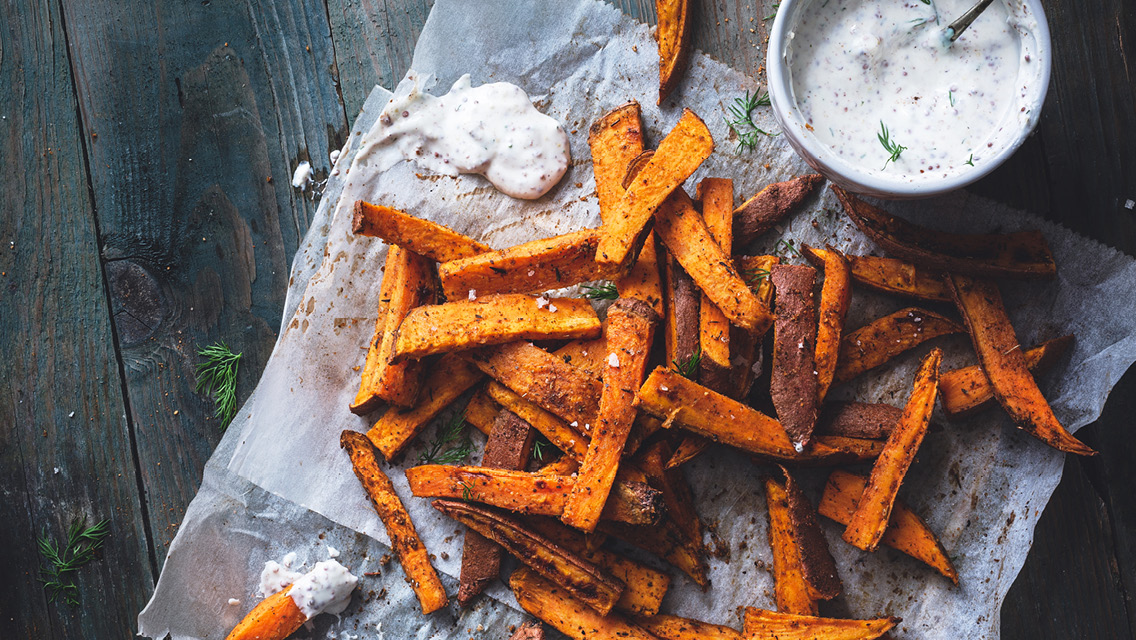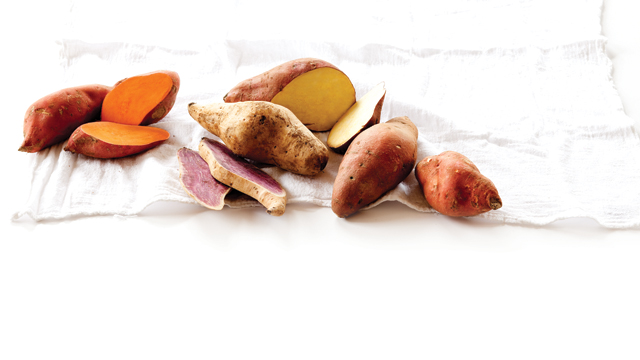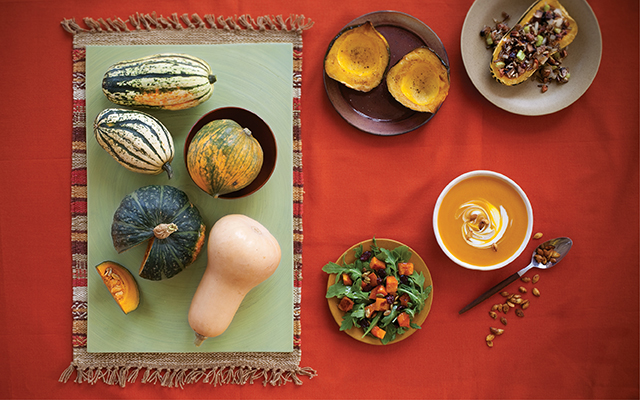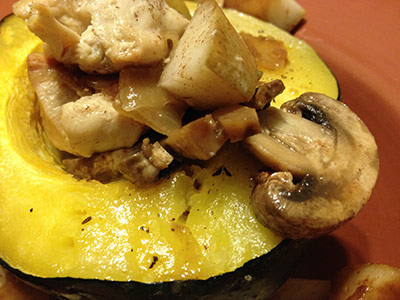Most Americans assume they’ve eaten yams, perhaps when they were served “candied” at a Thanksgiving dinner. But in reality, surprisingly few of us have ever enjoyed a real yam — they’re relatively rare in most U.S. grocery stores, where orange sweet potatoes, like garnets and jewels, have been called “yams” for nearly a century. So you may have to search for the real thing, but rest assured, the effort is well worth it. Yams (try Hawaiian, Korean and sweet yams for starters) are delicious and versatile and can help reduce your risk of heart disease, lower cholesterol and control blood pressure. Here are some tips on tracking them down — and then eating them up.
Food Basics
A tropical plant, yams contain more moisture and have higher natural sugar content than sweet potatoes. Yams are long and cylindrical and can weigh from a few ounces to 120 pounds. (They’re often sold in chunks by weight.) Their rough, thick skin may be white, pink or brownish black. The flesh comes in tones of off-white, yellow, pink and purple. Although they are relatively hard to find in most American grocery stores, more than 200 varieties are grown worldwide. You may have to prod your local grocer to stock true yams, or look for them in African, Caribbean or Asian food markets. When purchasing, select dense yams without traces of softness or mold.
Nutritional Know-How
Yams are high in vitamins B6 and C, making them a good food to help reduce your risk for heart disease and to lower cholesterol. The purple-flesh varieties are high in anthocyanin and betalain, phytonutrients linked to improved brain function and antioxidant activity. Yams also pack an ample supply of potassium, which helps control blood pressure. The complex carbohydrates and fiber in yams release and absorb slowly into the bloodstream, making them a smart choice for steady energy. Herbal-medicine practitioners have long used wild yam (also called Chinese yam) and its extract to support kidney function and the female endocrine system.
Kitchen Tricks
- Store yams in a cool, dark, dry place for up to two weeks. Do not refrigerate.
- Wash yams, and remove the skin with a vegetable peeler or paring knife.
- To keep a yam from rolling when you’re cutting it into desired sizes, cut off a 1/4-inch slice lengthwise from one side, making a flat surface. Then place the flat side on a cutting board to continue slicing.
Eat Up!
Always cook yams before eating. Most are too dry to bake, so after peeling and cutting the yams into the desired size, cook them by boiling, steaming or roasting with other vegetables. Yams’ earthy taste complements spicy or heavily flavored lean meats, hearty fish stews and roasted poultry.
- Boil or steam yams, and serve them diced or mashed as a side dish.
- Shred yams, and include them in fritters or pancakes.
- Yams and rich ingredients such as milk, coconut milk, eggs and butter are a delicious combination. When recipes that include these ingredients call for potatoes or sweet potatoes, you can substitute yams if you like.
- For a quick and tasty dish, purée cooked yams with milk, and season with tamari, coriander, cumin and cayenne.
- Add julienned yams to stir-fries.
- Roast yams with sliced fennel, onions and mushrooms for a delicious side dish.
Types of Yams
Yam, ñame (pronounced ny-AH-may) and igname (EEn-yahm) are the generic names most often seen in U.S. markets. The appearance and flavors of yams are as diverse as its name.
- Cushcush yams (also called American yam, mapuey or ñame mapuey) are small and elongated, like a sweet potato, and often resemble a mitten or a horse’s hoof. Their skin may be charcoal to purplish. When cooked, they give off the delicious aroma of fried bacon and eggs. Cushcush yams rank among the most prized yams for their pleasant neutral flavor and cooking qualities.
- White yams (also called ñame blanco or water yam) are the most commonly found yams in food markets. They have dark skin and their pale flesh is crisp, slippery and may froth when cut. The flavor of white yams is slightly sweet and delicate.
- Purple yams are not common in North America, but you might have luck finding them at ethnic food markets. Look for ratala, as they’re called by Philippine grocers, or kand, in Indian markets. This relatively small yam — 1/2 to 1 1/2 pounds — is well worth the search. With a thin, bark-like skin and lavender-violet flesh that turns a deep red-violet when cooked, purple yams are lightly sweet with a touch of smoke and nuttiness.
- African white yams (also called Guinea yam, ñame guineo, white Guinea yam and Ghana yam) are very similar to water yam. They are used to make fufu, a traditional dish of Africa and the Caribbean. Here’s how: Peel and dice the African white yams, then boil, drain, and pound with a mortar and pestle until a stiff, glutinous dough forms. Finally, mold the dough into small balls, and break with fingers to dip into stew.
Sweet Cinnamon Mashed Yams
Conscious Cuisine®
Makes 10 servings
- 2.5 pounds yams, peeled and diced
- 1 quart water
- 1 tsp. sea salt
- 1 stick butter, cut into pieces
- 1 1/2 tsp. cinnamon
- 1/4 tsp. white ground pepper
- 1/4 cup maple syrup
Directions
- Heat the water, yams and salt in medium saucepan. Bring to a boil and cook for 35 minutes.
- Drain the yams, and place in mixing bowl.
- Mash with potato masher, and stir in the remaining ingredients and mix well.
Per 1/2 cup serving: Calories 240; Protein 2 g; Total Fat 9 g; Saturated Fat 6 g; Carbohydrates 37 g; Dietary Fiber 5 g; Cholesterol 25 mg; Sodium 330 mg|
Baked Puffed Yams
Conscious Cuisine®
Makes six servings
- 2 pounds yams, peeled and diced
- 1 cup hot, low-fat milk
- 2 eggs, beaten
- 1/4 cup grated, sharp cheddar cheese
- 1 tbs. butter
- 1 tsp. sea salt
- Pinch of pepper
Directions
- Preheat the oven to 350 degrees F. Lightly grease an 11 x 9-inch baking pan.
- Place the yams in a saucepan, and cover with water. Bring to a boil, and cook until soft. Drain, place in mixing bowl and mash.
- Add the hot milk, eggs, cheese, butter, salt and pepper. Beat with an electric mixer on high for four to five minutes, or until yams are puréed.
- Spread into prepared pan, and bake for 20 minutes.
Per serving: Calories 250; Protein 7 g; Total Fat 6 g; Saturated Fat 3 g; Carbohydrates 44 g; Dietary Fiber 7 g; Cholesterol 85 mg; Sodium 490 mg
This article has been updated. It originally appeared online on December 1, 2007.




This Post Has 0 Comments